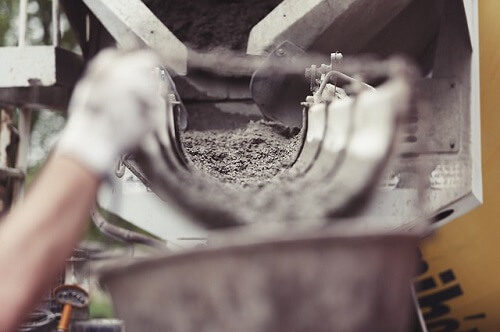Cement is a binding material which makes a bond between aggregates and reinforcing materials together. With the development of technology, quality and types of cement have also developed. So there are different types of cement for different construction works.

Types of Cement
Cement is mainly classified into two categories depending on the hardening and setting mechanism. These are-
Along with these main types, depending on the composition and characteristics there are many types of cement. Followings are the other cement types:
- Ordinary Portland Cement (OPC)
- Portland Pozzolana Cement (PPC)
- Rapid Hardening Cement
- Quick Setting Cement
- Low Heat Cement
- Sulphate Resisting Cement
- Blast Furnace Cement
- High Alumina Cement
- White Cement
- Colored Cement
- Air Entraining Cement
- Expansive Cement
- Hydrophobic Cement
Brief descriptions of these cement types with their uses are given below.
Hydraulic Cement
As the name indicates, hydraulic cement is those which harden by hydration in the presence of water. Limestone, clay, and gypsum are the main raw material to produce non-hydraulic cement. This raw material is burned at a very high temperature to manufacture Hydraulic Cement.
Hydraulic cement (cement that not only hardens by reacting with water but also forms a water-resistant product) produced by pulverizing clinkers which consist essentially of hydraulic calcium silicates, usually containing one or more of the forms of calcium sulfate as an inter ground addition.
Non-Hydraulic Cement
The non-hydraulic cement doesn't require water to get harden. It gets with the help of carbon dioxide (CO2) from the air. This type of cement needs dry conditions to harden. Lime, gypsum plasters, and oxychloride are the required raw material to produce non-hydraulic cement. Example: slaked lime is a non-hydraulic cement.
Ordinary Portland Cement (OPC)
In usual construction work, Ordinary Portland Cement is widely used.
Portland cement clinker is a hydraulic material which shall consist of at least two-thirds by mass of calcium silicates, (3 CaO·SiO2, and 2 CaO·SiO2), the remainder consisting of aluminium- and iron-containing clinker phases and other compounds. The ratio of CaO to SiO2 shall not be less than 2.0. The magnesium oxide content (MgO) shall not exceed 5.0% by mass.
The composition of Ordinary Portland Cement:
- Argillaceous or silicates of alumina (clay and shale)
- Calcareous or calcium carbonate (limestone, chalk, and marl)
Uses of Ordinary Portland Cement
- It is used for general construction purposes.
- It is also used in most of the masonry works.
{adselite}
Portland Pozzolana Cement (PPC)
Pozzolans are natural or synthetic materials that contain silica in reactive forms. It reacts with calcium hydroxide generated by hydrating cement to form additional cementations materials when it is finely divided. The composition of Portland Pozzolana Cement:
- OPC clinker
- Gypsum
- Pozzolanic Materials (Fly ash, volcanic ash, and Calcined clay or silica fumes.)
Uses of Portland Pozzolana Cement
- PPC is usually used in hydraulic structures, marine structures, construction near the seashore, dam construction, etc.
- It is also used in pre-stressed and post-tensioned concrete members.
- As it gives a better surface finish, it is used in decorative and art structures.
- It is also used in the manufacture of precast sewage pipes.
Read More:
Rapid Hardening Cement
When finely grounded Tri-calcium silicate (C3S) is present in OPC with higher content, it gains strength more quickly than OPC. This type of OPC is called Rapid Hardening Cement. It’s initial Setting Time 30 minutes and Final Setting Time 600 minutes.
Uses of Rapid Hardening Cement
- Rapid hardening cement is mostly used where rapid construction is needed like the construction of pavement.
- It also gives high strength.
We have published three articles on rapid hardening cement on our website. In case you want to learn more about RHC, you can visit the following link.
Quick Setting Cement
Quick setting cement is the cement which sets in a very short time. The initial setting time is 5 minutes and the final setting time is 30 minutes. The composition of Quick Setting Cement:
- Clinker
- Aluminum sulfate (1% to 3% by weight of clinker)
- The aluminum sulfate increases the hydration rate of silicate.
Uses of Quick Setting Cement
- It is used in underwater construction.
- It is also used in rainy & cold weather conditions.
- It is used a higher temperature where water evaporates easily.
- Used for anchoring or rock bolt mining and tunneling
Low Heat Cement
It is a spatial type of cement which produces low heat of hydration during the setting. Some chemical composition of Ordinary Portland Cement is modified to reduce the heat of hydration. The chemical composition of low heat cement:
- A low percentage (5%) of tricalcium aluminate (C3A)
- A higher percentage (46%) of declaiming silicate (C2S).
Uses of Low Heat Cement
- It is used for the construction of dam’s large footing, large raft slabs, and wind turbine plinths.
- It is also used for the construction of chemical plants.
Sulphate Resisting Cement
Sulfate resisting cement is used to resist sulfate attacks in concrete. Due to the lower percentage of Tricalcium aluminate, the production of calcium sulpho-aluminates gets reduced.
Uses of Sulphates resisting Cement
- Construction in contact with soils or groundwater having more than 0.2% or 0.3 % g/l sulfate salts respectively.
- Concrete surfaces subjected to alternate wetting and drying such as bridge piers, concrete surface in the tidal zone, apron, Building near the seacoast.
- Effluent treatment plans, Chimney, Chemical industries, water storage, sumps, drainage works, Cooling towers, Coastal protective works such as sea walls, breakwaters, tetrapods, etc.
Blast Furnace Cement
Portland cement clinker and granulated blast furnace slag are intergraded to make blast furnace cement. A maximum of 65 percent of the mixture could be comprised of blast furnace slag.
Uses of Blast Furnace Cement
- It is highly sulfate resistant
- Frequently used in seawater construction.
High Alumina Cement
High Alumina cement is obtained by mixing calcining bauxite (it’s an aluminum ore) and ordinary lime with clinker during the manufacture of OPC. In which the total amount of alumina content should not be lesser than 32% and it should maintain the ratio by weight of alumina to the lime between 0.85 to 1.30.
Uses of High Alumina Cement
- It is used where concrete structures are subjected to high temperatures like workshops, refractory, foundries, etc.
- It also used where the concrete is subjected to frost and acidic action.
White Cement
White cement is quite similar to Ordinary Portland Cement except for color. Amounts of iron oxide and manganese oxide are low in White Cement. It is expensive then OPC so not economical for ordinary work.
Uses of White Cement
- It is usually used in decorative work.
- It can also use for traffic barriers, tile grouts, swimming pools, roof tiles patching materials, and terrazzo surfaces.
Read More about White Cement:
Colored Cement
To make 5 to 10 percent of suitable pigments are ground with OPC. Types of pigments are selected according to the desired color.
Uses of Colored Cement
- Colored cement is used for different decorative work.
Air Entraining Cement
It is seen that entrainment of air or formation of gas bubbles while applying cement increases resistance to frost action, fire, scaling, and other similar defects. Air-entraining cement is a special type of cement which entrains tinny air bubbles in concrete.
It is produced by grinding minute air entertaining materials with clinker by adding some resinous materials e.g. vinsol resin to ordinary portland cement.
When the water in concrete gets frizzed due to low temperature, it expands. When air-entraining cement, the air voids in concrete provides space for water to expand without cracking concrete. But this type of cement does not provide high strength in concrete.
Uses of Air-Entraining Cement
- Especially it is used in areas where the temperature is very low.
- It also resists the Sulphet attack.
- It is used where the de-icing chemical is used.
Expansive Cement
In the hydration process, the expansive cement expands its volume. It can be possible to overcome shrinkage loss by using expansive cement.
There are three types of expansive cement:
- K Type expansive cement
- M Type expansive cement
- S Type expansive cement
K Type expansive cement
Raw materials of these types of cement
- Portland cement
- Anhydrous tetracalcium trialuminate sulfate (C4A3S)
- Calcium sulfate (CaSO4)
- Lime (CaO).
M Type Expansive Cement
Raw materials of these types of cement
- Portland cement clinkers
- Calcium sulfate.
S Type Expansive Cement
Raw materials of these types of cement
- Portland cement clinkers
- Calcium sulfate (High amount)
- Tricalcium aluminate (C3A) (High amount)
Uses of Expansive cement
- It is used in the construction of the pre-stressed concrete component.
- It is also used for sealing joints and grouting anchor bolt.
- In the construction of different hydraulic structures, this type of cement is used.
Hydrophobic Cement
To resist the hydration process in the transportation or storage stage, clinkers are ground with water repellent film substance such as Oleic Acid or Stearic Acid. These chemicals form a layer on the cement particle and do not allow water to mix and start the hydration process. When cement and aggregate are thoroughly mixed in the mixer, protective layers break and start normal hydration with some air-entrainment which increases workability.
Uses of Hydrophobic Cement
- Usually, it is used in the construction of water structures such as dams, spillways, or other submerged structures.
- It is also used in the construction of underground structures like tunnel etc.

